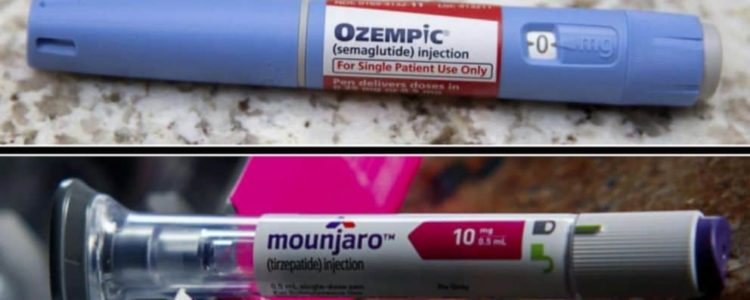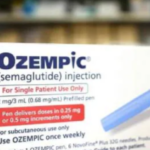
Lately, I can’t help but notice the buzz surrounding the weight loss drugs Ozempic and Mounjaro. Everywhere I look, from health news to social media, they’re the talk of the town. With celebrities and fitness fanatics endorsing them, I felt the urge to delve deeper into these miracle pills. As a trusted Sarasota registered dietitian, I would like to shed light on this trending topic.
A brief background of Ozempic and Mounjaro.
Initially introduced for diabetes management in 2017 and 2021 respectively, these two have recently been greenlit for weight loss by the FDA. This means that anyone who wants help shedding a few pounds can sign up. Celebrities have certainly started this trend, making it seem like the perfect fix for overcoming the struggle with the scale!
At the heart of these drugs lie the GLP-1 peptides. These peptides play a crucial role in modulating appetite and stabilizing blood sugar levels. Essentially, they spur insulin release and tweak how swiftly nutrients are absorbed into our bloodstream. They even increase the release of satiety hormones, meaning you can get full on far less calories. Finally, these magical drugs seemingly erase cravings for addictive foods like French fries!
This sounds fantastic you must be thinking, what could possibly go wrong?
Reality Check: A Few Key Factors to Consider Joining the Craze:
The allure of quick fixes is undeniable. However, every coin has two sides, and it’s my duty to present a balanced view:
Cost: These medications come a hefty cost, especially if insurance isn’t covering it for medically necessary diagnosis. Brace yourself for 1,000 dollars a month, to give yourself a weekly injections.
Potential Undesirable Side Effects: Nausea, diarrhea, gas, burping and vomiting. Most troubling though, is the loss of lean body mass that may be the result of severe calorie and protein restriction.
Weight Gain Rebound: If you stop taking the medication abruptly for a variety of reasons, there are reports of a rebound in appetite, weight gain – sometimes even more than what was shed.
What YOU can DO instead:
My Natural Recommendations for Activating GLP-1!
If you Before resigning yourself to a future filled with potential side effects or pricking needles, here are my personal suggestions for naturally triggering the GLP-1 pathway:
Focus on getting adequate fiber: Fibrous vegetables such as: Broccoli, Brussels , Artichokes to name a few stars, low fructose fruits such as berries or kiwi, finally consider adding the supplement psyllium husks to increase your insoluble fiber intake. Again, the fiber will slow transit time and help to trigger those satiety hormones, so you can fell full with less food!
Every Meal needs to include Protein: Great choices are grass-fed, lean meats, wild fish, pasture-raised eggs, Organic dairy or non-gmo tempeh for a good plant source. Protein is known to be the most satiating of ALL macronutrients, meaning you do not feel full unless you have consumed enough amino acids (the building blocks of protein). Digesting protein in order to get the essential amino acids, takes time and also triggers the release of GLP-1 peptides.
Fermented Foods for the gut bugs: Great sources are kefir, sauerkraut, and kimchi. The diversity and composition of gut microbiota play a significant role in various physiological processes in the human body, including the modulation of glucose homeostasis and appetite regulation. GLP-1 (glucagon-like peptide-1) is an incretin hormone secreted from the enteroendocrine L-cells of the intestine in response to nutrient ingestion and is pivotal for maintaining glucose balance.
Exercise AFTER a meal: Exercising after eating can influence various metabolic pathways, and there’s some evidence to suggest it can influence GLP-1 release. Exercise increases blood flow to various parts of the body, including the intestines. Enhanced blood flow may facilitate the secretion of gut hormones like GLP-1.
When you exercise after eating, your muscles use the glucose from your meal for energy. This can lead to a faster drop in post-meal blood glucose levels, potentially triggering a response to stabilize those levels. GLP-1, due to its role in influencing insulin and glucagon, can be part of this stabilization.
Several factors can influence the response, such as the type of food consumed, the intensity and duration of exercise, and individual metabolic differences. But there’s evidence to suggest that exercise, particularly after meals, can play a role in modulating GLP-1 pathways and overall metabolic health.
Nature’s Supplements: Berberine has been traditionally used in Chinese medicine for its anti-diabetic properties. Research suggests that berberine can up-regulate the expression of GLP-1 in the intestine. In addition to directly influencing GLP-1, berberine may also improve insulin sensitivity and reduce hepatic glucose production, both of which are beneficial for diabetes management.
Resveratrol is a polyphenol found in grapes, berries, and peanuts. It’s known for its anti-oxidative and anti-inflammatory properties. Studies indicate that resveratrol might increase the secretion of GLP-1 in the intestines, possibly through the activation of Sirtuin 1 (SIRT1). SIRT1 plays a role in regulating metabolism and can affect the secretion of GLP-1. Resveratrol also has been shown to improve insulin sensitivity in some experimental models.
Green tea contains polyphenols, the most notable being epigallocatechin gallate (EGCG). EGCG has been shown to enhance GLP-1 secretion in some studies. The mechanism may involve the inhibition of dipeptidyl peptidase-4 (DPP-4), an enzyme that breaks down GLP-1. Thus, by inhibiting DPP-4, green tea might increase the levels of active GLP-1 in the body. Green tea’s effect on metabolism and fat oxidation can further support its role in managing blood sugar levels.
Curcumin is the active compound in turmeric and is known for its anti-inflammatory and antioxidant properties. Some animal studies have shown that curcumin can enhance the secretion of GLP-1, potentially through its anti-inflammatory effects. Curcumin might also help improve insulin function and reduce oxidative stress, which are beneficial for managing diabetes.
Ginseng, particularly, American ginseng and Korean red ginseng, have been studied for their potential anti-diabetic effects. Ginsenosides, the major active compounds in ginseng, might influence the secretion of GLP-1. Some studies suggest that ginsenosides can increase the release of GLP-1 and inhibit its degradation by DPP-4. Additionally, ginseng might improve blood sugar control by enhancing insulin sensitivity and modulating carbohydrate metabolism.
My Final Thoughts
As our understanding of science expands, we’ll always be introduced to new solutions. This may turn out to be a fantastic, even life-saving tool for some, but optimally it should be part of a well-balanced diet and healthy lifestyle. Whenever you find yourself tempted by the next big thing in weight loss, remember to consult trusted professionals. And if you’re in Sarasota, don’t hesitate to reach out for some personalized registered dietitian counseling. Here’s to genuine, tailored guidance for a healthier you!
Check out more videos in my YouTube Channel


